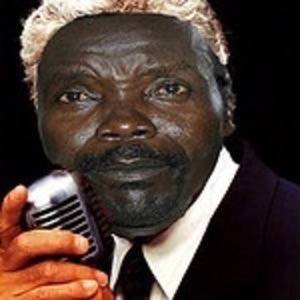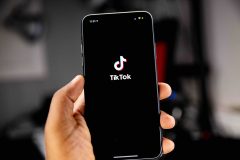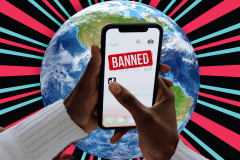The Kony 2012 video by the U.S. non-profit Invisible Children is now the most viral video of all time. The video relies upon a very simple narrative and two opposing forces: The white American male hero wants to defeat the bad guy, Ugandan war lord Joseph Kony, and make the future better for children, especially his own. The video is narrated entirely by the Invisible Children Co-Founder Jason Russell.

Kony 2012 has succeeded in part because it echoes and amplifies a classic narrative that America buys into and loves: The white male savior, swooping into Africa to save “those poor people,” and coming out as the hero, the masculine father figure whose blonde-haired, blue-eyed five-year-old boy will one day do for the world what his dad tried to do. As such, the video hardly gives a voice to the people it is trying to “save,” instead painting them as helpless one-dimensional victims exploited for the purposes of cajoling a Western audience out of its Internet-amplified apathy.
On social media sites, Kony 2012 was most viewed by people ages 18-29 years, quickly becoming a trending topic on Twitter. Younger adults were more than twice as likely as older adults to watch the video on YouTube or Vimeo. As of March 13, it had 76 million views on YouTube and 16 million on Vimeo. Today it has more than 83 million total views. Yet the narrative is problematic.
The video has also been criticized by Ethan Zuckerman, who states that the message is overly simplified – and that doing that to such narratives can actually be more harmful.
“The Kony story resonates because it’s the story of an identifible individual doing bodily harm to children. It’s a story with a simple solution, and it plays into existing narratives about the ungovernability of Africa, the power of US military and the need to bring hidden conflict to light.”
What Zuckerman did not explicitly point out – and what Colorlines completely nails on the head – is the narrative’s heavy reliance on the white patriarchal father figure, who is literally out to “save” Africa. It’s an old story with a new twist. It’s the white male hero complex at its finest.
“Despite the group’s best efforts, the campaign is still taking heat over its portrayal of Africans as victims whose only hope lay in the actions – and wallets – of white saviors,” writes Colorlines’ Jamilah King. “And critics say it’s that centuries-old narrative that’s in part responsible for the campaign’s viral success.”
Breaking Down the Narrative: Glorifying the “Hero,” Turning Evil into Celebrity
“We come here to save our life,” says Jacob Acaye, the only Ugandan child who has any voice in this video says. The imagery of him at the beginning of this video is in fact old footage – Jacob is now a 21-year-old law student living in Kampala. (In the video he looks like he’s about 12-years-old.) He was picked for the video because of his English-speaking capabilities.
Russell is understandably moved by Jacob’s honesty about his dire situation. You’d have to be a robot not to be. He responds with something both dramatic and heartfelt: “Jacob, it’s OK,” he says with reassurance. Then he tells the viewer: “Everything in my heart told me to do something.”
That something was to become a hero, to get serious about capturing Joseph Kony and freeing the children who are under his reign. And he’s doing it all for his five-year-old son, Gavin, who makes an appearance shortly thereafter.
In a questionable move which undermines and potentially threatens the innocence of his five-year-old child for the benefit of social media celebrity-dom, Russell films Gavin as he asks him about “what his daddy keeps doing by going to Africa.” Apparently, he and Gavin had not discussed this up until right that moment.
“You stop the bad guys from being mean,” says Gavin.
Yet who are these bad guys? Gavin thinks it’s “the Star Wars people.” But now Russell corrects him, explaining what Joseph Kony – whom Gavin can identify visually – is actually doing.
“As such, the video hardly gives a voice to the people it is trying to ‘save,’ instead painting them as helpless one-dimensional victims exploited for the purposes of cajoling a Western audience out of its Internet-amplified apathy.”
“This is Joseph Kony,” he tells his five-year-old son, “and this is Jacob [a former member of the LRA]. Joseph Kony…he has an army, and he takes children from their parents and he gives them a gun and he makes them shoot and kill other people.”
“But they’re not going to do what he says because they’re nice people?” replies Gavin.
In a hushed, perhaps guilt-inducing narrative twist that elicits empathy from the viewer, Russell says that he “couldn’t explain to Gavin the details of what Joseph Kony really does, because the truth is that Joseph Kony abducts kids just like Gavin.”
Wait, what? Come again? No, Joseph Kony does not abduct kids like Gavin, a white, five-year-old boy who appears to live quite comfortably with his filmmaker dad in Los Angeles. The children in Uganda are nothing like Gavin, save for the fact that they are also children. And Gavin’s dad is anything but the parents whose children have been abducted and harmed by Kony. But the narrative works – the Internet loves a hero.
This is not to say that what Invisible Children is doing is wrong. In fact, quite the opposite – it’s empowering to many, and has the potential to at least raise awareness. But the narrative is the same – it is condescending, all-American, and quite reminiscent of Christian missionary ideologies, suggesting that the white savior must come out and save the non-Western people.
Nevertheless, the fact that this video has 83 million views is not only shocking but hopeful – and proves that this sort of narrative is what most resonates with a social media audience that just wants to feel… something, under the pretense of a familiar narrative structure. And who better to play the all-time evil villain that Joseph Kony, who is listed as number one most-wanted by the International Criminal Court. In 2005, he was indicted for war crimes by the International Criminal Court in The Hague, Netherlands. He might just be the most evil man that the world doesn’t even know – and he is thus the perfect character for Russell’s white hero narrative.
After introducing all of the characters in this narrative – Joseph Kony, bad guy; Jason Russell, white American male savior; little Gavin, innocent child who we viewers need to “make the future better” for; Jacob, Ugandan child soldier survivor; and many nameless children soldiers – the video lays out exactly how Invisible Children is going to capture Joseph Kony. Like everything, it will start with the help of celebrities, athletes and billionaires like Rihanna, George Clooney and Mark Zuckerberg, Russell says. What better patrons than the rich and famous? Ryan Gosling, the Internet’s dreamboat, and Oprah are already in. Next up is the politicians – that’s where *you* come in, Internet user. And everything will be shared and spread via social networks. Sounds like a hero quest? Care to join?
Fame as a Weapon: Killing the Bad Guy on the World Wide Internet Stage
There’s nothing worse than being famous before you’re ready to be seen. Kony is a celebrity that no one knows about – and this campaign aims to change that. Again, Russell pivots back to innocent Gavin – the beautiful blonde-haired blue-eyed boy who he uses as an example of “the future.” That’s exactly what Russell aims to do with his viral video campaign.
“If my son were kidnapped and forced to kill, it would be all over the news,” says Russell’s voice over a shot of his adorable blonde-haired blue-eyed boy. “When I die, I want the world we leave behind is one that Gavin can be proud of. Says Gavin adoringly, to his dad: “I’m gonna be like you dad, I’m gonna come with you to Africa.”
The only imagery of actual Africans that we are shown is Jacob, at the beginning, random children who have been implicated in Kony’s evil doings, and plastering of Kony. By the end of the video, Kony’s face is burned into our brains – we fear him, we hate him, we want to make him famous and then murder him.
To make that happen, all you need to do is send a tax-deductible donation of at least $10, buy a $10 Kony bracelet or buy a $30 action kit that makes you an official Internet-ed activist. Then go forth and share the 30-minute Invisible Children video with the world.
The White Savior Complex Performed on Social Media
The video makes clear that every once of us should rise up and stop Joseph Kony so that Gavin, and kids like Gavin, don’t have to deal with issues like this. The Africans who actually speak in this video – namely, Jacob – have little autonomy, portrayed as victims. Nothing about this video is at all empowering to the people it is seeks to “save.” Tavia Nyong’o, associate professor of performance studies at New York University, said the following to Colorlines:
“When you don’t know anything about a situation, it’s easy to project a familiar scenario. People talk about the ‘white savior complex’ and it sounds like that’s a metaphor, but in fact there’s been a lot of literal right wing Christian evangelism in the region,” she says. “There’s this idea of rescuing the helpless African which goes back to 19th century missionary complex.”
It comes as no surprise that Jason Russell, co-creator of the Kony 2012 video, describes himself as a Christian. Among the groups funding Kony 2012 are anti-gay, creationist Christian Right, including the California-based Caster family, who is one of the biggest funders behind anti-same sex marriage Proposition 8. Oprah, who is a supporter of LGBT rights, gave $2 million to Invisible Children – but that’s not something IC cares to advertise. Oh, and Invisible Children also received at least $100,000 in 2008 from the National Christian Foundation, which is one of the biggest funders of the antigay, creationist Christian right.
The Hero’s Fall, The Victim’s Voicelessness
The image of white, idealized masculinity is never as slick as it seems. Rather, it is always problematic, eventually giving way to some sort of darkness underneath the seeming purity. The hero usually brings this misery upon himself – his flaws eventually rise to the surface, his vulnerabilities exposed, and his secrets become public knowledge through what is usually a series of unfortunate events.
“The hero usually brings this misery upon himself – his flaws eventually rise to the surface, his vulnerabilities exposed, and his secrets become public knowledge through what is usually a series of unfortunate events.”
Shortly after the media bonanza died down, Invisible Children Co-Founder and Kony 2012 star Jason Russell was found masturbating and under the influence of something on a corner in Los Angeles. Why? Perhaps he was unable to handle the social celebrity that the video’s virility brought on. Or maybe he realized how he had really portrayed the Ugandan people he was trying to “save.” The trashmasters at TMZ.com thankfully captured a 10-second video of what happened. It’s far too cheap to post.
“[Kony 2012] simplifies the story of millions of people in northern Uganda and makes out a narrative that is often hard about Africa, about how hopeless people are in times of conflict,” Ugandan journalist Rosebell Kagumire told Colorlines. “If you are showing me as voiceless, as hopeless, you have no space telling my story, you shouldn’t be telling my story.”
Malcolm Webb for AlJazeera followed a screening of Kony 2012 in a north Ugandan village. “For many here,” Webb says in the report, “the video is simply puzzling.” It depicts white Americans who don’t have a clear connection to Uganda. Soon, says Webb, “puzzlement turns into anger.” Men who are watching the video see it as exploiting devastating local occurrences for the benefit of a Western non-profit organization. Says Webb: “Rocks are thrown, the screening comes to a halt, and the crowd scatters into the night.”
“Kony Bennet” Flickr image via David Conch Condon.










